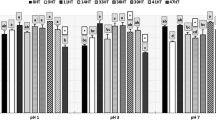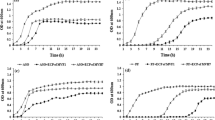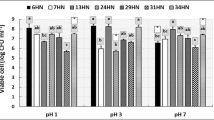Abstract
The production of ornamental fishes has been intensified to attend the global market. With this expansion, an increase in infections and infirmities has been observed, most of which are attributed to pathogenic bacteria. Dietary supplements to improve growth and immunity of these animals have been introduced as a safe way to control and prevent disease outbreaks. This study therefore aims to isolate, identify, select and evaluate strains of lactic acid bacteria that show potential as probiotics for Pterophyllum scalare. Of 16 initial isolates, five strains were molecularly identified as Enterococcus faecium. Profiles of probiotic candidate strains were based on: catalase test and hemolytic activity; in vitro tolerance responses to NaCl (0.5; 1.0; 1.5; 2.0; 2.5 and 3.0%), pH (4, 5, 6, 8, and 9), and bile salts (5%); pathogen inhibition halo size maximum growth rate; and final counts of viable cells. In vivo effectiveness of the best performing strain in vitro was determined by growth and survival parameters for post-larvae over a period of 40 days. All strains fulfilled the criteria as probiotics in animals, with Strain 4 showing the best results in vitro, and improving growth and viability of fish in vivo.

Similar content being viewed by others
References
Anvisa – (2017) Agência Nacional de vigilância Sanitária. Alimentos com alegações de Propriedades Funcionais e ou de Saúde, Novos Alimentos/Ingredientes, Substâncias Bioativas e Probióticos. IX. Lista de alegações de propriedade Funcional. Available at http://www.anvisa.gov.br/alimentos/comissões/tecno_lista_alega.htm. Accessed 25 May 2017
Assis GB, Tavares GC, Pereira FL, Figueiredo HC, Leal CA (2017) Natural coinfection by Streptococcus agalactiae and Francisella noatunensis subsp. orientalis in farmed Nile tilapia (Oreochromis niloticus L.). J Fish Dis 40(1):51–63
Balcázar JL, Vendrell D, Blas I, Ruiz-Zarzuela, Muzquiz JL, Girones O (2008) Characterization of probiotic properties of lactic acid bacteria isolated from intestinal microbiota of fish. Aquaculture 278:188–191
Boyer M, Wisniewski-Dye F (2009) Cell-cell signaling in bacteria: not simply a matter of quorum. FEMS Microbiol Ecol 70(1):1–19
Cyrino JEP, Bicudo AJA, Sado RY, Borghesi R, Dairiki JK (2010) A piscicultura e o ambiente – Uso de alimentos ambientalmente corretos em piscicultura. Rev Bras Zootec 39:68–87
Doan HV, Hoseinifar SH, Dawood MAO, Chitmanat C, Tayyamath K (2017) Effects of Cordyceps militaris spent mushroom substrate and Lactobacillus plantarum on mucosal, serum immunology and growth performance of Nile tilapia (Oreochromis niloticus). Fish Shellfish Immunol 70:87–94
Doan HV, Hoseinifar SH, Khanongnuch C, Kanpiengjai A, Unban K, Kim VV, Srichaiyo S (2018) Host-associated probiotics boosted mucosal and serum immunity, disease resistance and growth performance of Nile tilapia (Oreochromis niloticus). Aquaculture 491:94–100
Erkkilä S, Petäjä E (2000) Screening of commercial meat starter cultures at low pH and in the presence of bile salts for potential probiotic use. Meat Sci 55:297–300
Essa MA, El-Serafy SS, El-Ezabi MM, Daboor SM, Esmael NA, Lall SP (2010) Effect of different dietary probiotics on growth, feed utilization and digestive enzymes activities of Nile tilapia, Oreochromis niloticus. J Arab Aquacult Soc 5:143–161
Furuya WM, Souza SRD, Furuya VRB, Hayashi C, Ribeiro RP (1998) Pelletized and extrused diets for reversed nile tilapia (Oreochromis niloticus L.) males, in finishing phase. Cienc Rural 28(3):483–487
Gillor O, Etzion A, Riley MA (2008) The dual role of bacteriocins as anti and pro-biotics. Microb Biotechnol 81:591–606
Hall TA (1999) BioEdit: a user-friendly biological sequence alignment editor and analysis program for windows 95/98/NT. Nucleic Acids Symp Ser 41:95–98
Hernandez LHH, Barrera TC, Mejia JC, Mejia CG, Del Carmen M, Dosta M, De Lara Andrade R, Sotres JAM (2010) Effects of commercial probiotic lactobacillus casei on the growth, protein content of skin mucus and stress resistance of juveniles of the porthole livebearer Poecilopsis gracilis (Poecilidae). Aquac Nutr 16:407–411
Hjelm M, Bergh O, Riazza A, Nielsen J, Melchiosen J, Jensen S, Ducan H, Ahren P, Birkbeck H, Gram L (2004) Selection and identification of autochthonous potential probiotic bacteria from turbot larvae (Scophthalmus maximus) rearing units. Syst Appl Microbiol 27(3):360–371
Jatobá A, Mouriño JLP (2015) Efeito do Lactobacillus plantarum no trato intestinal de alevinos de Oreochromis niloticus. Ciência Animal Brasileira 16:45–53
Jatobá A, Vieira FD, Neto CB, Silva BC, Mouriño JLP, Jeronimo GT, Dotta G, Martins ML (2008) Utilização de bactéria ácido-lácticas isoladas do trato intestinal de tilápia-do-nilo como probiótico. Pesq Agrop Brasileira 43(9):1201–1207
Jin JD (2006) Molecular typing random amplification of polymorphic DNA (RAPD) and detection of virulence genes of Salmonella enterica serovar Gallinarum Biovar Gallinarum. Jpn Soc Vet Sci 68:1321–1326
Kim YR, Kim EY, Choi SY, Hossain MT, Oh R, Heo WS, Lee JM, Cho YC, Kong IS (2012) Effect of a probiotic strain, Enterococcus faecium, on the immune responses of olive flounder (Paralichthys olivaceus). J Microbiol Biotechnol 22(4):526–529
Kinouchi FL, Maia DC, De Abreu Ribeiro LC, Placeres MC, De Valdez GF, Colombo LL, Rossi EA, Carlos LZ (2012) A soy-based product fermented by enterococcus faecium and lactobacillus helveticus inhibits the development of murine breast adenocarcinoma. Food Chem Toxicol 50(11):4144–4148
Kotob MH, Menanteau-Ledouble S, Kumar G, Abdelzaher M, El-Matbouli M (2016) The impact of co-infections on fish: a review. Vet Res 47(98):1–12
Lorentz RH, Ártico S, Silveira AB, Einsfeld A, Corção G (2006) Evolution of antimicrobial activity in Paenibacillus spp. strains isolated from natural environment. Lett Appl Microbiol 43(5):541–547
Madani NSH, Adorian TJ, Farsani HG, Hoseinifar SH (2018) The effects of dietary probiotic Bacilli (Bacillus subtilis and Bacillus licheniformis) on growth performance, feed efficiency, body composition and immune parameters of whiteleg shrimp (Litopenaeus vannamei) postlarvae. Aquac Res 49(5):1926–1933
Maradonna F, Nozzi V, Santangeli S, Traversi I, Gallo P, Fattore E, Mita DG, Mandich A, Carnevali O (2015) Xenobiotic-contaminated diets affect hepatic lipid metabolism: implications for liver steatosis in Sparus aurata juveniles. Aquat Toxicol 167:257–264
Martins FS, Barbosa FHF, Penna FJ, Rosa CA, Nardi RMD, Neves MJ, Nicoli JR (2005) Estudo do potencial probiótico de linhagens de Saccharomyces cerevisiae através de testes in vitro. Revista de Biologia e Ciências da Terra 5(2)
Mello H, Moraes JRE, Niza IG, Moraes FR, Ozório ROQ, Shimada MT, Engracia-Filho JR, Claudiano GS (2013) Efeitos benéficos de probióticos no intestino de juvenis de Tilápia-do-Nilo. Pesqui Vet Bras 33(6):724–730
Merrifield DL, Dimitroglou A, Foey A, Davies SJ, Baker RT, Bøgwald J, Castex M, Ringø E (2010) The current status and future focus of probiotic and prebiotic applications for salmonids. Aquaculture 302(1-2):1–18
Monroy-Dosta MC, Castro-Barrera T, Fernández-Perrino FJ, Mayorga-Reyes L (2010) Inhibition of Aeromonas hydrophila by probiotic strains isolated from the digestive tract of Pterophyllum scalare. Revista mexicana de ingeniería química 9(1):37–42
Naser SM, Thompson FL, Hoste B, Gevers D, Dawyndt P, Vancanneyt M, Swings J (2005) Application of multilocus sequence analysis (MLSA) for rapid identification of Enterococcus species based on rpoA and pheS genes. Microbiology 151(7):2141–2550
Nithya V, HALAMI PM (2013) Evaluation of the probiotic characteristics of Bacillus species isolated from different food sources. Ann Microbiol 63:1229–1137
Pennacchia C, Ercolini D, Blaiotta G, Pepe O, Mauriello G, Villani F (2004) Selection of Lactobacillus strains from fermented sausages for their potential use as probiotics. Meat Sci 67:309–317
Prang G (2007) An industry analysis of the freshwater ornamental sherry with particular reference to the supply of Brazilian freshwater ornamentals to the UK market. Revista UAKARI 3:7–51
Ramirez C, Cifonni EMG, Pancheniak EFR, Soccol CR (2006) Microrganismo láctico com características probióticas para ser aplicados em la alimentación de larvas de camarón y peces como substituto de antibiótico. La Alimentacion Latinoamericana 264:70–78
Ringo E, Olsen R, Gifstad TO, Dalmo RA, Amlund H, Hemre GI, Bakke AM (2010) Prebiotics in aquaculture: a review. Aquac Nutr 16:117–136
Sambrook J, Russell DW (2001) Molecular cloning: a laboratory manual Cold Spring Harbor Laboratory Press, New York
Sambrook J, Fritschi EF, Maniatis T (1989) Molecular cloning: a laboratory manual. Cold Spring Harbor Laboratory Press, New York
Sanger F, Niicklen S, Coulson AR (1977) DNA sequencing with chain-terminating inhibitors. Proc Natl Acad Sci 74(12):5463–5467
Schultze (1823) Pterophyllum scalare in GBIF Secretariat 2017. GBIF Backbone Taxonomy. Checklist dataset. https://doi.org/10.15468/39omei. Accessed via GBIF.org on 2019-01-14
Silva BC, Mouriño JLP, Vieira FN, Jatobá A, Seiffert WQ, Martins ML (2011) Haemorrhagic septicaemia in the hybrid Surubim (Pseudoplatystoma corruscans x Pseudoplatstoma fasciatum) caused by Aeromonas hydrophia. Aquac Res 43(6):908–916
Souza DM, Martins GB, Piedras SRN, Pouey JLOF, Robaldo RB, Leite FPL (2012) Probiotic actions of Bacillus cereus var. toyoi and Saccharomyces boulardii in silver catfish (Rhamdia quelen) larvae culture. Rev Bras Zootec 41:815–819
Sugita H, Ohta K, Kuruma A, Sagesaka T (2007) An antibacterial effect of Lactococcus lactis isolated from the intestinal tract of the Amur catfish, Silurus asotus Linnaeus. Aquac Res 38:1002–1004
Sun P, Wang JQ, Jiang YM (2010) Effects of Enterococcus faecium (SF68) on immune function in mice. Food Chem 123(1):63–68
Tamura K, Stecher G, Peeterson D, Filipski A, Kumar S (2013) Mega6: molecular evolutionary genetics analysis version 6.0. Mol Biol Evol 30(12):2725–2729
Tarasova E (2010) The influence of probiotic Enterococcus faecium strain L5 on the microbiota and cytokines expression in rats with dysbiosis induced by antibiotics. Benefic Microbes 1(3):265–270
Temminck & Schlegel (1846) Paralichthys olivaceus in GBIF Secretariat 2017. GBIF Backbone Taxonomy. Checklist dataset. https://doi.org/10.15468/39omei. Accessed via GBIF.org on 2019-01-14
Vásquez JA, Gonzalez MP, Murado MA (2005) Effects of lactic acid bactéria cultures on pathogenic microbiota from fish. Aquaculture 245:149–161
Verschuere L, Rombaut G, Sorgeloos P, Verstraete W (2000) Probiotic bacteria as biological control agents in aquaculture. Microbiol Mol Biol Rev 64:655–671
Vieira FN, Jatobá A, Mouriño JLP, Vieira EA, Soares M, Silva BC, Seiffert WQ, Martins ML, Vinatea LA (2013) In vitro selection of bacteria with potential for use as probiotics in marine shrimp culture. Pesq Agrop Brasileira 48(8):998–1004
Vine NG, Leukes WD, Kaiser H (2004) In vitro growth characteristics of five candidate aquaculture probiotics and two fish pathogens growth in fish intestinal mucus. FEMS Microbiol Lett 321:145–152
Funding
The authors thank National Council of Scientific and Technological Development-CNPq-Brazil for the financial support (432622/2016-0) and grant to Rodrigo Yudi Fujimoto (CNPq 305195/2016-6) and Maurício Laterça Martins (CNPq 305869/2014-0).
Author information
Authors and Affiliations
Corresponding author
Ethics declarations
Experiment approved by ethical committee, number 03.13.09.015.00.00 (attached).
Conflict of interest
The authors declare that they have no conflict of interest.
Additional information
Publisher’s Note
Springer Nature remains neutral with regard to jurisdictional claims in published maps and institutional affiliations.
Rights and permissions
About this article
Cite this article
Dias, J.A.R., Abe, H.A., Sousa, N.C. et al. Enterococcus faecium as potential probiotic for ornamental neotropical cichlid fish, Pterophyllum scalare (Schultze, 1823). Aquacult Int 27, 463–474 (2019). https://doi.org/10.1007/s10499-019-00339-9
Received:
Accepted:
Published:
Issue Date:
DOI: https://doi.org/10.1007/s10499-019-00339-9




